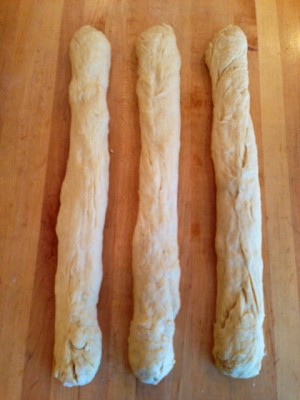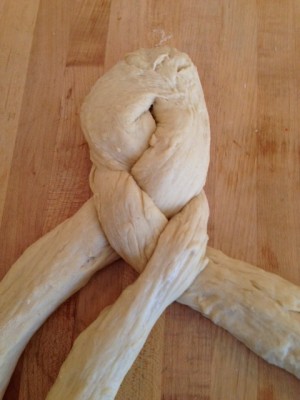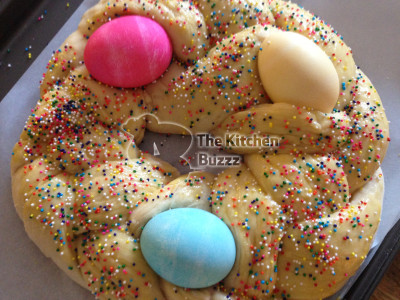Every year in central and southern Mexico, the Day of the Dead is traditionally celebrated on November 1 and 2. Although this holiday coincides with the Roman Catholic Church’s All Souls Day and All Saints Day, indigenous cultures have fused the Church’s celebration with the ancient custom of honoring their departed ones.
Memorial altars are erected with photographs of the dead and what used to be their favorite foods. Local bakeries sell Pan de Muertos or Day of the Dead Bread. This sweet bread is made with eggs, anise seeds, flour, sugar and yeast. The loaf is usually round, adorned with dough that is shaped to resemble bones. Although the ingredients are basic, the flavors and texture of this bread literally melt in your mouth!
Ingredients for Bread:
3/4 cup milk (low fat or whole milk)
1/4 cup water
1 package active-dry yeast (Fleischmann’s Rapid Rise Instant Yeast®
2 large eggs
1/4 cup butter, room temperature
1/4 cup plus 2 tablespoons granulated sugar
1 teaspoon vanilla extract
1/2 teaspoon salt
1-1/2 tablespoons anise seeds
3 to 3-1/2 cups all-purpose, unbleached flour.
Ingredients for Glaze:
3 tablespoons freshly-squeezed orange juice
1/2 cup granulated sugar
Prepare the Yeast:
1. In a small saucepot, combine the milk and water; heat until mixture is lukewarm.
2. Place the yeast and lukewarm liquid in a metal bowl or a small, separate metal saucepot; cover and set aside (on a wood or plastic surface) for 13 minutes.
Mix the Dough:
1. After 13 minutes, the yeast mixture will look puffy – transfer it to a 2-quart mixing bowl or a stand mixer fitted with a bowl.
2. Stir in the eggs, butter, sugar, vanilla, salt and anise seeds. Beat on low until mixture is barely uniform.
3. With electric beaters on low, stir in 1 cup flour at a time, until a sticky dough has formed.
4. At this point, clean off the beaters. Using a wooden spoon, add 1/4 to 1/2 cup flour until the dough amalgamates and becomes a little firmer (not hard).
5. Flour your hands and the dough (lightly).
6. Transfer dough onto a lightly-floured board. Knead dough until it is smooth and elastic.
Set Dough to Rise:
1. Oil a clean, 1-1/2 to 2-cup mixing bowl with vegetable oil.
2. Transfer dough to the oiled bowl; cover with aluminum foil and set dough to rise on a wood surface or in a cold oven with door closed. Let dough rise for 20 minutes.
3. After 20 minutes, transfer dough to a lightly-floured surface and punch it down.
4. Remove a 5-inch piece of dough from the dough ball.
5. Shape the largest dough ball into a flat round form and place it on a parchment-lined baking sheet measuring 16 inches by 11 inches.
6. Take the smaller dough ball and pull off 4 to 5 walnut-sized pieces. Roll each piece out to about 4 to 5 inches.
7. Place one rolled dough piece going from the top center and down the sides of dough round on parchment-lined baking sheet.
8. Add the remaining rolled dough pieces in a similar way and evenly spaced all around the dough round.
9. Shape a round knob on top center of the dough round. The rolled dough pieces will look like long bones on the bread.
10. Set dough to rise for 30 minutes on a wood surface or cold oven with door closed.
Bake the Bread:
1. After 30 minutes, transfer the baking sheet with dough to a wood surface; set aside while preheating oven.
2. Preheat oven to 375°F.
3. When oven is preheated, place the baking sheet with risen dough on a rack positioned in center of oven.
4. Bake the bread for 10 minutes.
5. After 10 minutes, lower oven temperature to 350°F; bake the bread for an additional 10 to 15 minutes or until it looks golden brown. To test doneness: insert a pointed knife in center of bread. If knife comes out clean, the bread is done. If not, bake for an additional 5 minutes and test once more.
6. Transfer baking sheet with bread to a counter to cool.
Make the Glaze:
1. When bread is completely cool, place 1/4 cup sugar and the orange juice in a small saucepot and heat until the sugar melts.
2. Let the orange juice-sugar glaze cool completely.
3. Using a basting brush, glaze the bread. Sprinkle the bread with remaining sugar.
Enjoy Day of the Dead Bread with the best Mexican coffee on the market -Jaguar Forest® Organic Coffee, sold at Erewhon supermarkets in Los Angeles, Venice and Calbasas, California; and also at Vicente Foods, Los Angeles; Rainbow Acres, Culver City and Marina del Rey, California.
Jaguar Forest® Organic Coffee can also be found online: http://jaguarforest.com
Text and Day of the Dead Photograph ©2016 Nancy DeLucia Real
Jaguar Forest® Coffee Photograph ©2016 Jaguar Forest® Coffee Company











 Nancy DeLucia Real is an art historian and chef. She has led culinary courses at the Italian Cultural Institute, The Getty Center and The Getty Villa and is a former member of the Culinary Historians of Southern California. Nancy's gastronomy training took place in the heart of Italy under the tutelage of her grandmother. She has taught international cuisine at Williams Sonoma and Sur la Table Stores. Nancy's art history & culinary courses are ongoing at various institutions. She also teaches private cooking classes.
Nancy DeLucia Real is an art historian and chef. She has led culinary courses at the Italian Cultural Institute, The Getty Center and The Getty Villa and is a former member of the Culinary Historians of Southern California. Nancy's gastronomy training took place in the heart of Italy under the tutelage of her grandmother. She has taught international cuisine at Williams Sonoma and Sur la Table Stores. Nancy's art history & culinary courses are ongoing at various institutions. She also teaches private cooking classes. 

